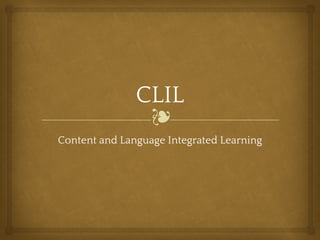
CLIL Content Learning Guide
- 1. ❧ CLIL Content and Language Integrated Learning
- 2. ❧ ❧ The term CLIL was coined by David Marsh, University of Jyväskylä, Finland (1994): "CLIL refers to situations where subjects, or parts of subjects, are taught through a foreign language with dual- focused aims, namely the learning of content and the simultaneous learning of a foreign language." What is CLIL?
- 3. ❧ ❧ The approach is topic focused and the students learn the language through the content. When the content is interesting and relevant to their other studies, students may be more motivated than when the focus is on the nuts and bolts of the language (i.e. grammar). Advantages in the use of CLIL
- 4. ❧ ❧ By using topics that they are familiar with and, if possible, that they have recently studied in their mother tongue, students will be able to learn more as they will already know a lot of the content and context. This familiarity enables them to pay attention to details that they would otherwise miss. Advantages in the use of CLIL
- 5. ❧ ❧ Rather than starting with the small and building to the large, it works the other way around. This ‘top-down’ approach, using existing knowledge, contextual clues and overall meaning is almost certainly faster and probably a more useful way of learning, than a ‘bottom-up’ approach. Advantages in the use of CLIL
- 6. ❧ ❧ Many English language teachers worry about using CLIL materials because they feel they don’t have the background knowledge of the subject. Disadvantages in the use of CLIL
- 7. ❧ ❧ Another potential disadvantage is the view that other subject teachers might take, for example: 'Why doesn’t the English teacher stick to teaching English and leave my subject to me?’ Disadvantages in the use of CLIL
- 8. ❧ ❖ The basis of CLIL is that content subjects are taught and learnt in a language which is not the mother tongue of the learners. ❖ Knowledge of the language becomes the means of learning content. ❖ Language is integrated into the broad curriculum. ❖ Reading is the essential skill. ❖ CLIL is based on language acquisition rather than enforced learning. How Does CLIL Work?
- 9. ❧ ❖ In intial lessons, the center of attention is on the language the students use or learn. ❖ Language is seen in real-life situations in which students can acquire the language. This is natural language development which builds on other forms of learning. ❖ CLIL is long-term learning. Students become academically proficient in English after 5-7 years in a good bilingual programme. How Does CLIL Work?
- 10. ❧ ❖ Fluency is more important than accuracy and errors are a natural part of language learning. Learners develop fluency in English by using English to communicate for a variety of purposes. ❖ Learning is improved through increased motivation and the study of natural language seen in context. When learners are interested in a topic they are motivated to acquire language to communicate. ❖ L1 may be used to explain, if necessary. How Does CLIL Work?
- 11. ❧ ❏ Content-Based Teaching Concentrates on the topic or subject matter. During the lesson students are focused on learning about something. ❏ Communicative Approach Emphasizes interaction as both the means and the ultimate goal of study. ❏ Lexical Approach An important part of learning a language consists of being able to understand and produce lexical phrases. ❏ Humanistic Approach Gives great importance to background knowledge, experiences and values of the individuals. CLIL focuses on
- 12. ❧ Read the fallowing text: A small example The miniskirt is a skirt whose hemline is high above the knees (generally 200-300 mm above knee-level). Its existence is generally credited to the fashion designer Mary Quant, who was inspired by the Mini Cooper automobile, although André Courrèges is also often cited as its inventor, and there is disagreement as to who invented it first.
- 13. ❧ Ask your students to look for lexis related to the subject, fixed expressions, collocation and other lexis A small example The miniskirt is a skirt whose hemline is high above the knees (generally 200-300 mm above knee-level). Its existence is generally credited to the fashion designer Mary Quant, who was inspired by the Mini Cooper automobile, although André Courrèges is also often cited as its inventor, and there is disagreement as to who invented it first.
